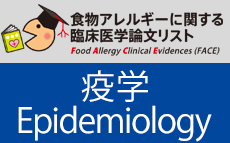ゴマアレルギーの人口が世界的に増えている?/Sesame allergy: a growing food allergy of global proportions?
更新日:2016年10月21日
| Author: | Venu Gangur, DVM, MVS, PhD; Caleb Kelly, BS; and Lalitha Navuluri, DVM |
|---|---|
| Title: | Sesame allergy: a growing food allergy of global proportions? |
| Citation: | Ann Allergy Asthma Immunol. 2005;95:4–11. |
| URL: | https://pubmed.ncbi.nlm.nih.gov/16095135/ |
| Abstract: | Objective: To present an up-to-date synopsis on the global prevalence, natural history, nature of allergens, and immune mechanisms of sesame allergy. Data Sources: We performed a literature search using the PubMed database. We obtained information on regulatory issues from the Web pages of respective agencies. Study Selection: The PubMed search was performed using the algorithm sesame AND allergy. Date restriction was not used, and only articles in English were considered. The articles obtained were screened for additional references to work not obtained in the initial search. Each article was analyzed, and a pooled source of published information was generated. Results: Evidence was found for increased reporting of sesame allergy during the past 5 decades, with reports mostly from developed countries. Clinically, most sesame allergy was presented in at least 2 major forms: (1) immediate hypersensitivity, often expressed as systemic anaphylaxis, associated with positive skin prick test and/or IgE antibody test results to sesame proteins with some cross-reactivity with other foods, and (2) delayed hypersensitivity to lignin-like compounds in sesame oil clinically expressed as contact allergic dermatitis. There were a few cases of immediate hypersensitivity to sesame with negative skin prick test and/or IgE antibody test results that were confirmed by oral challenge tests. Conclusions: Sesame allergy is a significant, serious, and growing problem. Evidence exists of the ability of protein and oil components of sesame to trigger immediate hypersensitivity via IgE antibody and delayed hypersensitivity via cell-mediated immune responses, respectively. |
| 邦文タイトル: | ゴマアレルギーの人口が世界的に増えている? |
| 一般向け要約 | 目的:ゴマアレルギーの世界的な有病率、自然歴、抗原の特性、免疫学的機序における最新の概要を示す。 データソース:我々はPubMedデータベースから論文を検索した。 研究の選定:PubMedでは“ゴマ”と“アレルギー”という言葉で検索し、発行年は問わず、英語の論文のみを選んだ。それぞれの論文を解析し、論文の情報を蓄積した。 結果:過去50年間でゴマアレルギーの報告は増加していた。そのほとんどは先進国からの報告であった。臨床的に、ゴマアレルギーは次の2つの臨床型に分けられた。(1)即時型の反応で、しばしばアナフィラキシーへ進展し、皮膚プリックテスト(SPT)陽性やゴマ特異的IgE抗体が陽性で、これはゴマ蛋白と他の食物と交差反応に関係がある。(2)ゴマ油に含まれるリグニン様混合物に対する遅発型の反応で、接触性アレルギー性皮膚炎の症状がでる。SPTや特異的IgEが陰性でも、食物経口負荷試験で即時型のゴマアレルギーが証明されるケースもある。 結論:ゴマアレルギーは増えており、重要で深刻な問題である。IgEを介する即時型反応を起こすゴマの蛋白や、細胞性免疫を介する遅発型反応を起こすゴマ油の働きが解明されている。 |
| 専門医コメント | 最近報告が増えている、ゴマアレルギーに関する調査です。ゴマアレルギーは先進国で増えており、アナフィラキシーを含む急激な症状を呈する即時型と、接触性皮膚炎を呈する遅発型に分けられます。前者は主に血液検査や皮膚検査で陽性となりますが、中には陽性を示さない例もあり注意が必要です。現在、ゴマアレルギーの原因物質が解明されてきています。 |

